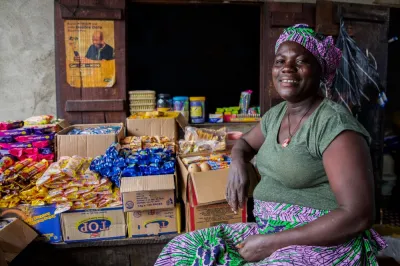Mobile Money and Interoperability: Competition vs. Financial Inclusion?

In the dynamic world of mobile money and financial inclusion, the concept of interoperability has taken center stage. Interoperability is a policy that allows transactions between users of different mobile money operators and aims to foster competition among these operators while enhancing access to financial services. But does it always strike the right balance?
Our study delves into the role of competition in shaping the behavior of mobile money companies and the corresponding impact on financial inclusion. Specifically, we examine the effects of platform interoperability with the aim of relating this change in competition to the profit margins of mobile money operators, their investment in pricing, network and infrastructure, and ultimately, how these investments affect financial inclusion.
The market structure for mobile money in Africa
To understand this complex relationship, it's essential to grasp the typical structure of this market. It comprises two main players: mobile network companies offering phone and internet services and mobile money companies specializing in payment exchanges. Often, these two entities are vertically integrated, creating a limited competitive environment but potentially expanding financial services to underserved areas as the companies have the incentive to expand their market by installing towers in more remote areas.
One central aspect of our study is the role of mobile phone towers, which are not a fixed cost for operators as they can grow or shrink their tower network depending on economic incentives. Mobile towers in Africa often have high variable costs, powered by expensive commodities like diesel fuel. This market structure implies that companies may reduce their tower network in response to negative shocks to mobile revenue.
Our hypothesis – a tradeoff between pricing and coverage
For our study, we hypothesize that the vertical integration between mobile network and mobile money companies results in higher fees charged to mobile money users, lowering consumer welfare and financial inclusion. At the same time, we theorize that the lack of competition provides incentives for mobile network companies to extend their reach to underserved locations, enhancing financial inclusion through increased geographical outreach.
Empirical insights from studying the deployment of platform interoperability
To test this hypothesis, we construct a novel dataset which collects information on the fee structure of more than 120 mobile money operators across all African countries from 2010 onward. The information on mobile money operators’ fee structure has been further combined with extensive documentation on companies' network coverage across all districts of Africa. Our empirical exercise requires the identification of a source of quasi-experimental variation that generates higher competition between mobile money companies. For this reason, we leverage a natural experiment that has unfolded in Africa over the period spanning from 2010 to 2020: the staggered deployment of platform interoperability.
Deployment of Interoperability

Notes: These maps show the staggered introduction of interoperability across African countries in four reference years. Interoperability is currently active in 20 African countries and 58 mobile money operators. Countries colored in blue are those ones in which interoperability is active.
In line with the main hypothesis, our findings show that the introduction of interoperability lowers fees on mobile money transactions, especially for small-value payments. At the same time, the increased competition which brings about those fee reductions also leads to reduced profit margins for mobile network operators, causing them to cut investments in towers. Thus, interoperability has negative effects on network availability, as countries that introduce interoperability experience a drop in their coverage, particularly severe for rural districts.
A focus on mobile money fee structure
The fee structure of mobile money operators has a significant impact on financial inclusion. Our comprehensive dataset on mobile money operators’ tariffs reveals a crucial pattern: fees are higher for lower-value transactions, placing a disproportionate burden on the poorest individuals who rely on small payments. As transaction values increase, fees decline progressively. This fee structure exacerbates the challenges faced by low-income individuals and hampers their ability to access mobile money, making any reduction in fees particularly helpful for advancing financial inclusion.
 Notes: This figure plots the yearly fees for sending mobile money between two users of the same operator. Fees are expressed as percentage of transaction values. In the left panel, each dot corresponds to the observation of any operator in any year, for only those operators which are not interoperable yet. The right panel, instead, shows interoperable operators. Transaction brackets, indicated by ordinal numbers on the x-axis, represent cross-country harmonized transaction value ranges: lower brackets correspond to lower transaction amounts.
Notes: This figure plots the yearly fees for sending mobile money between two users of the same operator. Fees are expressed as percentage of transaction values. In the left panel, each dot corresponds to the observation of any operator in any year, for only those operators which are not interoperable yet. The right panel, instead, shows interoperable operators. Transaction brackets, indicated by ordinal numbers on the x-axis, represent cross-country harmonized transaction value ranges: lower brackets correspond to lower transaction amounts.
Seeking a balanced approach
Our findings suggest that the competition-promoting policy of platform interoperability can have a positive effect on inducing lower fees but also have negative effects on network availability. So how can policymakers strike the right balance – helping promote competition in the mobile money market without hindering financial inclusion? We propose combining interoperability with subsidies for rural telecommunications, as our study presents evidence that this combination delivers lower fees without hurting coverage, offering a promising opportunity to expand access to financial services for rural and underserved populations.
In the ever-evolving landscape of financial inclusion, finding the right equilibrium is key. It's a journey that involves continuous evaluation, adjustment and innovation. As practitioners, let's keep exploring new ways to strike that balance and ensure that the benefits of mobile money reach everyone, regardless of where they are.



Interesting data set. Can you share more on the trajectory of fees from 2010 to-date? Have they gone down everywhere? Which are outliers? Why? At what rate? What is the differential between the reduction of rates in interoperable countries and non? Also, it would be interesting to look at the maturity of the market when interoperability was introduced. I would suspect that if it is introduced before the market scales it has different effects than if that is done afterwards. This might also be an indicator of the sophistication of the regulator in that country, which might detract from the power of the natural experiment design. Very excited about this data, please publish more!
Thank you, this is a very thoughtful comment. We are working at a new piece with some trends on fees and more information, hence, stay tuned! In terms of "market maturity", we had an earlier version focusing exactly on that. See this CEPR working paper, from page 40 onward: https://repec.cepr.org/repec/cpr/ceprdp/DP18124.pdf
Thank you for your comment. Let me answer point-by-point:
1) "Is it possible that the reduced investment in towers would have happened whether or not interoperability was implemented? " This is a difference-in-difference study. Therefore, our findings imply that there is a differentially higher decline in towers and signal in areas with interoperability. As a result, we are not ruling out that this reduction is not happening in areas where interoperability is not introduced.
2) "I also struggle to understand why operators would have a higher incentive to grow their network into rural areas if there was no interoperability." This is beyond the scope of our paper, but typically this is due to network effects. Low and middle-income countries have a lot of people migrating from rural to urban areas and they want to send remittances to their family, friends and peers in rural areas. Offering these services is one of the core reasons behind the popularity of mobile money.
Thank you for taking the time to respond Nicola.
Interesting findings. Is it possible that the reduced investment in towers would have happened whether or not interoperability was implemented? As mentioned, the cost of operating towers is high and variable. It would make sense for operators to divest their ownership of towers, as has been the case in recent years, to concentrate on the more profitable areas of business i.e. mobile money and its use cases.
I also struggle to understand why operators would have a higher incentive to grow their network into rural areas if there was no interoperability. If the operators are getting sufficient profits in urban areas, there would be little incentive to expand into rural areas. We see this very easily with agents and bank branches that concentrate in the more profitable urban areas. It may actually be dynamic rivalry from an entrant that may spur incumbents to expand into untouched areas rather than lack of interoperability. I think the mechanism through which you see this happening is not quite clear.
Leave a comment